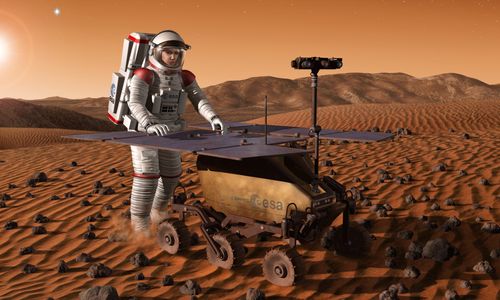
A In the 1800s, Italian astronomer Giovanni Schiaparelli used new higher powered telescopes to study the planet of Mars, where he saw a network of channels which he named 'canali'. In 1877, Schiaparelli made some drawings and maps of the surface of Mars. These maps showed the ‘canali’ or channels that he had seen. Then in 1894, astronomer Percival Lowell made a series of drawings of his observation of Mars from his observatory in Flagstaff, Arizona in the USA. As his drawings showed, Lowell was convinced that the canali were a great network of canals that had been created by intelligent life to be used as an irrigation system. Obviously, his drawings and his observations fueled the thought that there was life on Mars.
B The idea that there was life on Mars continued to gain momentum, and the idea soon became a popular subject in books of fiction. In 1898, a fictional book titled War of the Worlds was released. This book by English author H. G. Wells quickly became popular as it told the fictional story of a group of Martians who invaded the Earth with the intention to conquer the Earth and its people. In the book, the Martians used highly sophisticated technology to overwhelm the people living on the Earth. In 1912, American novelist Edgar Rice Burroughs wrote first in a popular series of eleven science fiction novels about Mars. Then on October 30, 1938, Wells and his troupe detailed the fictional invasion of New Jersey in the USA by Martians through a radio broadcast, which caused widespread panic in America. People who did not understand that the episode was fictional ran into the streets, not sure of what to do with the onset of the Martian invasion.
C Now, of course, we know much more about Mars. In July 1965, Mariner 4 returned photographs of a cratered and barren landscape, more like the surface of our moon than Earth. In 1969, Mariner 6 and 7 took 200 photographs of Mars's southern hemisphere and pole on fly-by missions, although neither mission offered much more information about life there. The 1975 Viking probes sent by the U.S.to collect samples offered more hope of finding evidence of life, although none was found.
D In fact, the whole notion that there was no life on Mars was thrown into doubt when a Martian meteorite found on the Earth was analysed. ALH84001 was discovered in December 1984 in Antarctica by members of the ANSMET project.The rock broke free from Mars about 17 million years ago and spent 11,000 years in the Allen Hills of Antarctica. Composition analysis by NASA revealed a kind of magnetite in association with certain microorganisms. They found carbonates 'resembling terrestrial microorganisms, terrestrial biogenic carbonate structures, or microfossils.' The size and shape were consistent with fossilized nanobacteria found on the Earth, but the findings were greeted with some skepticism by the scientific community.
E Scientists speculate that the lack of magnetic shield helped the solar wind blow away much of Mars's atmosphere over the course of several billion years. After mapping cosmic radiation levels at various depths on Mars, researchers concluded that any life within the first several meters of the planet's surface would have been killed by lethal doses of cosmic radiation. In 2007, it was calculated that DNA and RNA damage by cosmic radiation would limit life on Mars to depths greater than 7.5 metres below the planet's surface. Therefore, the best chance of discovering life on Mars may be in subsurface environments that have not yet been studied.
F Did Mars old liquid water in surface lakes or oceans years ago? Liquid water is necessary for all the metabolic processes of life on the Earth, so any evidence of water on Mars would indicate the existence of life. Certainly, it is an inhospitable place now, with its low atmospheric pressure, low temperature, and aridity. However, the Mars Express orbiter did detect huge reserves of ice at the planet's south pole in January 2004, and two months later NASA announced that its rover Opportunity had discovered evidence that Mars was, in the ancient past, a wet planet. This raised hopes that evidence of past life might be found on the planet today, although it has thus far proved elusive.
G Meanwhile, back on the Earth, researchers from the Centro de Astrobiologia in Spain and the Catholic University of the North in Chile, using a special detector called 'SOLID', have found an 'oasis' of microorganisms two meters below the surface of the Atacama Desert. “We have named it a 'microbial oasis' because we found microorganisms developing in a habitat that was rich in rock salt and other highly hygroscopic compounds that absorb water,” explained Victor Parro, researcher from the Centre of Astrobiology in Spain. “If there are similar microbes on Mars or remains in similar conditions to the ones we have found in Atacama,we could detect them with instruments like ‘SOLID'”, Parro highlighted.
H Even more intriguing, however, is speculation by the Spanish scientists that Martian samples could contain DNA, as Earthly life does, as their genetic code. It is extremely unlikely that such a highly specialized, complex molecule like DNA would evolve separately on the two plants, which would suggest there must be a common origin for Martian and Earthly life. If it originated on Mars and then spread to Earth - where it then evolved into the myriad forms of plants and creatures that exist today - then we would be faced with the conclusion that we are all Martians.